In the beginning of the film, the working-class Parondi family has just migrated to Milan from southern Italy. Unable to stay with the oldest son and his Milanese in-laws, they relocate to a housing project.
|
IMAGE
|
SHOT DESCRIPTION
|
ANALYSIS
|
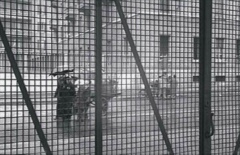 |
Editing: shot#1 fade in (can’t see it in this clip) Cinematography: LS establishing shot becomes MLS as characters move toward camera slight pan to the right, following the characters slight refraings all the way through to keep characters centered Sound: street noise Mise-en-scene: gate, lines across image, rainy street, mist, reflective |
Rocco and his family (Parondi) moving into new lodging, in a housing project in the outskirts of Milan. We see the family through the fence; their new home is visually like a prison. The day is rainy — typical of a Milanese winter but new to the family. They are not dressed for the weather and shiver against the cold. Drab, low-contrast image. |
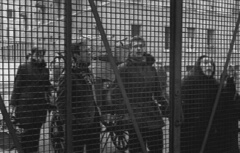 |
Editing: (same shot) Cinematography: MLS, widescreen, black figures on light background Sound: suddenly loud: Rosaria calls for the porter. offscreen sound (high reverb) of porter’s response Mise-en-scene: gesturing: cold; clothing: low class, immigrants (not winter clothes) |
Mom speaks, even if she has many grown up sons. She’s the boss. Even if they are actually entering (that is, outside), her cries holding the fence brings prison images to mind, calling for help/guards (that is, from the inside). Or rather, animals in the zoo, an association later reinforzed by the neighbors’ malicious gossip (ie: Africans = southerners = animals). The family huddles together — a group against an unfriendly northern society. |
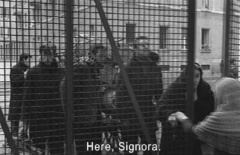 |
Editing: (same shot) Cinematography: MLS Sound: dialogue, two different dialects (Milanese and Southern) Mise-en-scene: porter appears from offscreen space; |
Porter speaks in Milanese; communication is difficult, lot of gesturing. [Native informant note: This is not dialect but accent — the film makes an effort to establish linguistic differences but at the same time seeks to make that difference comprehensible to a general audience]. Post-synchronized dialogue detaches voices from the space of the image. Widescreen: good for extended families, group portraits. Visconti heavily pictorial, his aristocratic education allows him to draw compositions from royal group portraits, ironically applied to this family. Reinforces the “epic” nature of the film. |
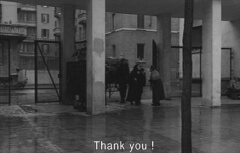 |
Editing: Shot #2, match on action as gate opens Cinematography: LS, pan following characters Sound: dialogue continues Mise-en-scene: reflections of rain, gestures for communication |
Wider shot: the lens “opens up” with the door. The camera remains detached from the characters: no POV shot, no eyeline match, not reverse shots of the family. Instead the shot stresses the relation of the family to the overwhelming municipal architecture. |
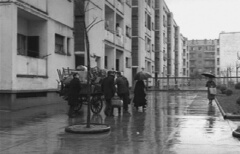 |
Editing: (same shot) Cinematography: LS Sound: noise of footsteps Mise-en-scene: cart, imposing postwar housing project, passing woman turns to look. |
We get a better look at the cart: ready for war, with mom as general; or exodus imagery. This family in exile from its traditional home. Camera cuts, now showing the family from the back, dwarfed by the architecture. The path looks like a corridor in a prison block, the identical apartments are like cells. They have been sent to the basement: a slow descent into hell. This is registered in the bodily attitude of the family members, dressed in black. |
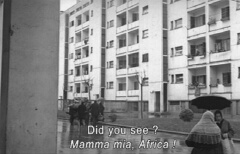 |
Editing: shot#3, match on action as the woman keep walking and meets the porter Cinematography: ELS of family; closer shot of gossiping couple,grey tone, ends with fade to black Sound: postrecorded close-up dialogue between the two Milanese women, make fun of the immigrants Mise-en-scene: big housing project, all houses are the same. Deep space connects commenting women to family. |
Again, the family is dwarfed by the prison-like project. The separation of the family in extreme background from the gossiping women in extreme foreground mirrors a cultural separation between north and south, even though they all belong to the same social class. |
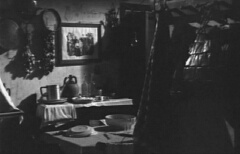 |
Editing: Shot #4; fade in Cinematography: darker image, slight track left then pan right across basement apartment to window; it is snowing Sound: silent Mise-en-scene: religious imagery, family photographs, simple food, no curtains, bare walls |
New scene: the objects indicate the low class and lack of education of the Parondi family. The objects associated with the family take over the function of dialogue in this long tracking/panning shot. The images indicate the importance of religion and the family, and their elementary eating and sleeping arrangements. The low key lighting in the image gives us a sense of the drabness of their existence in their new lodgings. The shot of the windows shows that they are buried underground. It is not yet dawn; they spend all the daylight hours working. The film shows that immigrants from the regions are even “lower” than the local working class. |
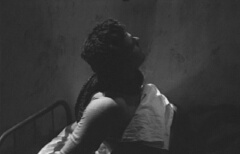 |
Editing: shot #5, cut Cinematography: crane shot rises with Rocco then tracks right with him as he walks across the room to the second window. Mirror of shot #4. Lights come on in the background. Sound: silent Mise-en-scene: Same objects we see in shot #4. gesturing: it’s cold. |
Rocco wakes up first and sleeps alone; he is different from his brothers; the most responsible, serious. As in the title, the film here visually singles out Rocco for special attention. The track back across the room reveals that he is sleeping in the “kitchen”. We see that it is snowing. |
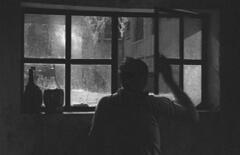 |
Editing: (same shot) Cinematography: track and pan left, as Rocco retraces his steps across the room. camera obstructed by pillar. Sound: window opening, voices of people waking up in the neighborhood Mise-en-scene: bottles of oil or wine in window, more of basement apartment |
Rocco opens the and realizes it is snowing (probably first time for the whole family). Neighbors are waking up too, to go to work: lights, noises; one gets the idea most people in the apartments share a similar social standing. The obstruction of the camera indicates the “reality” of the setting: the space is not arranged for optimum visibility but seems to exist “prior” to the filming (even though this may be a set). |
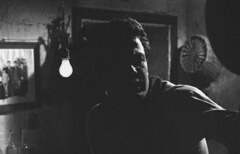 |
Editing: (same shot) Cinematography: MCU, as Rocco approaches the camera pan stops as Rocco reaches for the light switch Sound: click of light switch, Rocco calls to his brothers Mise-en-scene: bare bulb lights up room. bulb in image. heavily shadowed face. |
The harsh sidelighting on Rocco is part of a visual rhetoric that impresses on us the harshness of their lifestyle. In general the film is structured by strong contrasts: north/south, modernity/backwardness, city/country, education/ignorance and, ultimately, good and evil. The MCU starts to bring us closer to Rocco in the narrative: earlier he has been seen as part of his family; now the camera contemplates him alone. Alain Delon here is cast strongly against the romantic type he had established in France. |
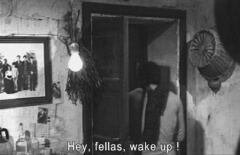 |
Editing: (same shot) Cinematography: MS as Rocco walks away from the camera into the adjacent room Sound: Rocco calls his brothers to wake up Mise-en-scene: family photograph on wall, whitewashed walls. |
The other brothers are in the next room. Later in the scene we’ll see the whole basement where the many Parondis live, virtually one on top of each other. The architectural / social characterization begun in this scene will continue in the following sequence. The bare bulb as another mark of poverty and improvisation, along with the bare walls and the hanging herbs etc. They were expecting to stay with the oldest son’s in-laws. Instead, they find themselves in this dungeon. |
